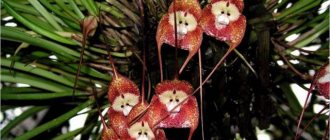This herbaceous perennial is also known as “sytov”, “sytovnik”, “Nile papyrus”, “palm cyperus”. It belongs to the sedge family, growing in the tropics, subtropics, and temperate climate zones with cool, rainy summers. Distributed in marshy lands and coastal areas of water bodies. At first glance, Cyperus is not very attractive, but in a dense planting it looks very impressive. Umbrella-shaped panicles of narrow leaves “sit” on thin stems, which in appearance resemble a dill umbrella or a small grassy palm.
The ancient Egyptians treated cyperus with special respect; even the name of the flower is translated from Egyptian as “gift of the river.” They built boats and baskets from it, made shoes, and ate healthy rhizomes.
In modern life, cyperus is a natural air purifier and a favorite treat for pets. By placing cyperus in the bedroom, you can significantly improve the microclimate in the room. The main benefit of moisture-loving flowers is air humidification: the mucous membranes do not dry out, we breathe easily, and in the morning we wake up fully rested.
Description of the flower
With its spectacular appearance, Cyperus decorates many corners of homes and offices, clinics and kindergartens, workshops of industrial enterprises and shop windows. With the help of Cyperus, you can organize green thickets on your balcony or terrace, swaying in the wind. In addition, Cyperus is a very useful flower.
It perfectly humidifies dry air and is a natural “vacuum cleaner”.
- Papyrus has long, bright green, flowering stems. Over time, they age, become yellowish and die. Such stems should be cut off in time so that new ones begin to appear in their place. The tops of the stems end in rosettes of whorled thin leaves.
- Linear leaves open in the form of umbrellas. They vary in length and are unevenly distributed. The result is a kind of sun rays that give the flower volume.
- The color of the plant is heterogeneous. It ranges from dark green to light green. The leaves are even two-colored. Sometimes there are white and brown strokes.
Cyperus is a flowering plant. Peduncles are triangular in shape. They are erect, but flexible, so they do not break under the pressure of the wind. Small, inconspicuous flowers of Cyperus are arranged singly or in a rosette. They are pale green, light brown or milky in color. Most often, flowering is observed in the summer, in June or July, but some varieties bloom throughout the summer until mid-autumn.
After flowering, small fruits appear - nuts or spikelets of a brownish color. Pollination occurs due to wind - fine pollen is quickly carried by the wind to nearby plants.
In the wild, some species of Cyperus grow up to five meters, forming dense, impenetrable thickets (at home they are much more modest - from 50 to 100 cm.) The root of Papyrus is located on the surface of the soil. It is long and creeping. Sometimes, instead of a root, spindle-shaped processes grow, which perform the function of a root and extract nutrients from the soil. The type of root depends on the species diversity, this should be taken into account when selecting suitable soil for the plant. Cyperus species with short roots are suitable for indoor cultivation in a pot or flowerpot.
When and how does it bloom
The swamp palm is a flowering plant that blooms buds regularly. But the flowers are inconspicuous, they do not add any special beauty; the plant is grown not because of them, but because of the decorative nature of its spreading leaves. Shades of flowers: pale green, brownish, beige.
Blooming Cyperus
Types of flowers
The flowers of the plant are inconspicuous, can be solitary or most often form rosette inflorescences. They do not add any special decorative effect to the plant. The flowers are bisexual, pollinated by the wind, and therefore do not have a perianth.
Flower shapes
The shape of the flowers is small spikelets, mostly gathered together. After flowering, brown fruits are formed, shaped like a box or, less commonly, a spike.
During the flowering period of Cyperus, fertilizing should be done a little more often, but the solution should be made less concentrated
It is also important to remove it from direct sunlight, but do not shade it too much
Trimming
Frequent pruning is not recommended for this plant, as it will slow down its growth. Only leaves that have been affected by disease or have already withered need it.
Note! If a variegated variety suddenly turns green, this should also be prevented by removing the stems with green foliage. If pruning has to be done during flowering, then all flowers must be removed.
Home care
In the warm season, the most suitable place to place Cyperus is in the fresh air, or even better, in an artificial pond. After all, this plant is a marsh grass, which means these conditions are its “home.” If you decide to decorate your summer cottage pond with cyperus, then it is absolutely not necessary to even remove it from the pot. Place it in the water with it. But just in a pot, among other garden and indoor plants spending the summer in the fresh air, it will feel no worse.
Of course, the summer street temperature, with all its daily changes, is quite suitable for Cyperus. If he lives indoors with you all the time, then the optimal temperature is considered to be +18-22 degrees, but this does not mean that he will not tolerate higher temperatures. Temperature drops in winter are also not particularly dangerous for Cyperus, but not below +12 degrees.
Lighting
In bright light, Cyperus will feel best. At the same time, it easily tolerates direct sunlight. But it’s especially nice that this is not a mandatory condition for its content. If it is not possible to provide it with a lot of light, cyperus will grow in partial shade, with virtually no damage to its decorative appearance.
Despite the low need for sunlight, Cyperus does not tolerate a long absence of sun, so short winter days need to be “extended” with the help of artificial lighting with fluorescent lamps. The eastern and western sides of the house are perfect when direct rays enter the room 4-6 hours a day. If all the windows are on the south side, then shade the light a little by placing the flower in the far corner away from the window. So the light will be bright, but diffused, which is important for active growth and flowering.
Watering and air humidity
These two points for caring for cyperus at home are the most important and require the most attention and effort. Cyperus comes from swamps, which means the moisture of the earth is very important for it. At normal summer temperatures it is impossible to fill it! Moreover, as I noted above, it will feel best in the summer in a pond.
Drying out the root system of Cyperus is unacceptable!
In summer, especially hot, regular, even frequent and abundant watering may not be enough. Therefore, choose the deepest pan for it and make sure that there is always water in it. Even better, take a spacious pot and place a pot of cyperus in it, while filling the pot with water to at least half the height of the pot with the plant. Such measures will provide the plant with a sufficient amount of moisture, and you will be spared from very frequent watering. In winter, when the plant is resting and if the temperature in the room is lower than it was in summer, it is enough to simply water the cyperus (preferably through a tray). In this case, watering should be regular, the soil should not dry out.
The same applies to air humidity. Cyperus will immediately react to dry air by blackening and drying out the tips of the leaves. Spray it regularly throughout the year.
Feeding
Cyperus responds gratefully to mineral fertilizer for indoor flowers, which is necessary for decorative foliage plants. Fertilizers are applied every 2-3 weeks throughout the growing season, reducing by a third in winter. Only a period of active growth can guarantee complete absorption of fertilizers; an excess is as harmful as a deficiency. Complex feeding should include nitrogen, potassium, and phosphorus minerals.
Fertilizer application rules:
- follow the manufacturer's dosage; there may be simple and concentrated formulations;
- halve the dose for young bushes;
- prevent the solution from getting on the green mass, which can cause burns;
- Nitrogen fertilizers are applied first during the season, which help the formation of green mass; potassium and phosphorus are added for flowering and vegetation;
- Before adding the solution, thoroughly water the soil, otherwise there is a risk of burning the roots.
Give fertilizers to the plant only in the warm season at intervals of 10-15 days. The most common fertilizers for Cyperus are suitable - a complete mineral complex. It doesn’t matter whether they are liquid or dry.
Cyperus transplant
Although it is often recommended to repot Cyperus only when necessary, as it grows, I recommend repotting it annually. If this is not done, the stem of the plant begins to turn yellow, the leaves become smaller, and there are fewer of them. In addition, given that the roots of the plant are constantly in a humid environment, anything can happen, including acidification of the soil and rotting of the roots. We should not forget that it still grows in a confined space. Replanting will allow you not only to renew the soil, but also to clean the roots, removing dead ones. At the same time, you can rejuvenate the plant and propagate it. On an industrial scale, in greenhouses, Cyperus is most often grown hydroponically; this is the most ideal environment. But at home, even a compact hydroponic installation looks like an alien element in the interior.
But growing Cyperus in hydrogel is just the thing! This is comfortable for the plant and looks very beautiful. But most often, amateur gardeners make do with ordinary soil mixture.
- The soil can be selected ready-made for moisture-loving indoor plants, or you can mix it yourself, maintaining an acid-base environment of pH 5-8.5.
- It will be great if you add sapropel or river silt to the soil.
- The ratio of peat soil, humus, and marsh silt is 1:1:1/6.
- The ratio of clay-turf soil, leaves, peat, river sand is 2:1:1:1.
- You can add brick chips, charcoal, and crushed eggshells, sifted from dust, to the bottom of the container. Cyperus grows well on hydroponic material, but it is better to follow the proportions for soil preparation.
Its simplest composition is as follows: peat, turf soil, humus and sand in equal parts. If possible, you can add part of the swamp silt to this mixture. If you plan to keep it in water in the summer, then to prevent the soil from being washed away, pour a decent layer of sand on top of it.
About growing problems and their solutions
The big advantage of plants that came to us from tropical latitudes is that their “native” natural insect pests are not found here, so the risk of getting infected by some overseas fly is minimized. And in general, cyperus plants have good immunity, which, however, does not completely exclude illness and damage from “domestic” pests.
Insect pests
If treated carelessly, Cyperus is threatened with:
- thrips;
- spider mite;
- scale insect;
- mealybug;
- whitefly butterfly.
To rid a flower of parasites, you need to make a soap solution from shavings of laundry soap and water and treat the infected plant with it. In more severe cases, special store-bought products will help. Chemists are advised to prefer organic preparations.
With properly organized care, no insects will attack Cyperus. The main pests of this flower are cats, which are ready to eat it completely. Home gardeners are strongly advised not to throw away damaged parts of the plant. Torn or bitten flower arrows can be easily rooted.
Diseases
Cyperus is considered quite resistant to disease. They can only be triggered by maintenance errors: “wrong” air humidity and soil condition. What can happen?
- Cyperus leaves turn yellow. The reason is moisture deficiency, dry roots. Shoots with yellow leaves are cut to the very root. Try not to make such mistakes again: the lost foliage color does not return.
- Cyperus is drying up. This sign indicates low air humidity. Prolonged exposure to dry air can lead to the death of the plant. Urgent treatment consists of daily spraying, immersing the flower pot in a container of water, and avoiding proximity to operating heating devices.
- Cyperus does not grow. Potential reasons are lack of lighting, the need for feeding, or the “crowdedness” of the flower pot.
- Cyperus leaves curl. This unpleasant transformation of leaves occurs if the flower is cold, especially at night.
Proper cultivation of Cyperus at home is impossible without taking care of the health of the moisture-loving Tropican during your vacation. Cyperus is almost the only indoor flower whose roots stand in water. Before leaving for a long time, water the cyperus generously and place it in a basin filled with water to half the height of the pot. To disinfect, add a few pieces of charcoal or five to six tablets of activated carbon into the water.
Reproduction of Cyperus
Cyperus reproduces very easily. The simplest and most commonly used method is propagation by division. Already from the age of two, Cyperus grows sufficiently and becomes suitable for division. Of course, the division of the bush occurs during transplantation.
Cuttings
Propagating Cyperus from cuttings is also not difficult. The cutting is taken from the top of the shoot, this is its tip, 15-20 centimeters long.
- It is cut under the knot. If necessary, the leaves of the apical rosette are trimmed to the required length.
- The cutting is placed in a container with light soil, sand, perlite or vermiculite of your choice. But! It is not planted traditionally, with the bottom down, but on the contrary - with the top towards the ground.
- At the same time, it is absolutely not necessary to sprinkle the “umbrella” of the Cyperus with earth; it is enough to fix it so that it is in maximum contact with it.
With this method of propagation, it should be taken into account that the cutting itself will not develop, it is needed for the formation of young shoots, so even if it shrivels during the rooting process, this is normal, and there is nothing wrong with that.
In water
Cyperus cuttings produce shoots in water no less successfully (this is how it reproduces in nature). To do this, its stalk is also placed in the water “upside down”. Sometimes they make it even more natural. The shoot is simply tilted and the top is lowered into a container of water. The effect is the same. Young shoots and roots usually appear within a month (sometimes earlier).
Seeds
Cyperus also reproduces by seeds. At home, you can collect your own seeds after the plant blooms, but if you grow it “from scratch,” you can buy it. Cyperus seeds are sown on the surface of a light sand and peat mixture and covered with a transparent cap or simply a piece of glass. During seed germination and seedling growth, keep the soil moist and the temperature at least +18 degrees. Sprouts will appear in 15-20 days.
If you bought the seeds in a store:
- Seeds from the bag are treated with a weak solution of potassium permanganate to disinfect.
- They are sown on prepared soil made of sand and peat in small containers; you can even use food containers by making holes in the bottom for drainage.
- The seeds are not covered with soil, but are only sprinkled with water from above, maintaining a constant level of humidity.
- For better germination, the seedling container is covered with film or glass, this creates a greenhouse effect.
- Remember that direct sunlight has a negative effect on the condition of plants; it is better to provide long daylight hours with diffused light.
- The ambient temperature should be at least 18 degrees, it is better to maintain stability so that sprouts appear faster.
- After 4-5 true leaves appear, the seedlings are planted in pots of 3 each.
Of course, no matter how you propagate cyperus, this is done in the spring. An exception may be reproduction by division. You can divide the cyperus bush at the beginning of summer.
Propagation by umbrellas - leaf rosettes
As the plant increases in size, another one appears in the center of each leaf rosette.
- The rosette can be plucked off, grabbing a little stem, placed in wet sand, ensuring the bottom heating of the soil to 24 degrees. In a few days, the cyperus will give roots. Such a shoot can be planted in prepared soil, providing standard care.
- Some do not pinch off the shoot, but bend the stem and cover it with soil. When roots appear, the shoot is separated with a knife and transplanted into a new pot.
- Germination in water gives good results: just throw the rosettes into the water and they will take root, after which the seedlings can be planted directly into the prepared pot.
Dividing the bush
- When replanting, you can divide the bush with a sharp, disinfected knife, and treat the cut areas with charcoal or activated carbon or ash.
- The finished bush can be planted immediately in the prepared place, providing fertilizing, watering, and favorable conditions. Important! The bush must be at least two years old, otherwise the root system will not be ready for division. Periodically you need to change the pot size so that active growth does not stop.
- Rhizomatous tubers can also be used to produce new bushes by simply planting them separately.
How to replant a houseplant Cyperus
Cyperus is replanted once a year, and as usual, this is done in the spring
A young plant can be replanted annually. With proper care, it develops quickly and requires a larger container. An adult plant is replanted only as needed.
How to transplant a flower correctly?
- You need to tilt the pot and carefully remove the plant, holding it with your fingers and the top of the soil with your palm.
- Transplantation is carried out without completely removing the earthen coma. After removing from the pot, just shake off the soil a little from the root system. If the roots are severely damaged (accidentally touched during transplantation or affected by rot), the unusable parts should be carefully removed and the old substrate should be thoroughly cleaned.
- When planting a new pot, no drainage is provided. This is what distinguishes it from many indoor flowers. Drainage does not make it possible to retain moisture for a long time and create “swampy” conditions.
- It is better to plant in the spring (March, April).
[adsp-pro-5]
How to choose a container for homemade cyperus?
Cyperus grow well and develop in width, so it is advisable for them to choose a pot whose width exceeds its height. Containers that are too spacious will not be suitable, as the flower will begin to devote a lot of energy to the development of rhizomes.
Diseases and pests
Cyperus is rarely attacked by pests, but sometimes spider mites, thrips, whiteflies, and scale insects can attack.
Signs of Cyperus pest damage:
- punctures along the edge of the sheet;
- deformation and yellowish tint of the leaf plate;
- cobwebs in the internodal spaces, on the back of the umbrellas;
- white dots on the inside of the leaf, midges around;
- cotton balls and a sweetish-sticky coating on the stem and leaves.
If cyperus is affected by pests, urgent sanitation is necessary. You can use folk remedies: prepare a soap, alcohol, oil solution or buy special insecticides. It is better to carry out the treatment outside so that no harmful substances remain in the house.
Despite the ease of cultivation, sylvestris has a number of features, knowledge of which will help you avoid diseases, and its appearance will delight you with its lush crown.
- If the leaves have become smaller and their color has changed to lighter, then the plant needs additional lighting. This happens in winter, especially in the northern regions, when daylight hours are less than 8 hours.
- Why do Cyperus leaves turn yellow? Dry air burns the leaves and flower tops; they turn yellow or brown if there is a lack of moisture. The solution will be abundant regular watering and installation of additional humidifiers. You should avoid being near heat sources: heating radiators, etc. You can place the pot in a larger pot with water to satisfy the plant’s need for moisture (water will cover the surface of the earth by 2-3 cm). The cause of yellowing of the leaves can be the usual depletion of the soil, when the roots completely fill the space in the pot and the plant is already cramped. It needs to be replanted into a larger container with soil replacement.
- High temperatures can cause the entire bush or its individual parts to wither: leaves, inflorescences, stem tips. Regular ventilation and indoor climate control will help solve the problem.
- The lack of growth or its slow pace indicates that it is time to change the flower pot for a larger one or it is time to change the soil. After replacing the soil and selecting a suitable container, active growth will continue and flowering will resume.
- On the south side, often in direct sunlight, the leaves become covered with gray spots. This means the plant has received sunburn. To prevent this from happening again, you need to cover the bush from direct rays.
- The softness of the leaves or their brown color indicates unfavorable growing conditions: low temperatures, stagnant water, dry air, direct sunlight. Compliance with Cyperus agricultural technology will allow you to avoid unpleasant incidents.
Problems during cultivation
The bush or its individual parts, leaves, stems and inflorescences, began to fade. The reason may be high ambient temperatures. It is necessary to regularly ventilate the room, monitor temperature and humidity readings. In the summer, take the plant out into the fresh air, closer to a pond, or at least onto a terrace, balcony, loggia, where a fresh breeze blows.
Cyperus has stopped growing or the rate of its development has slowed down. The reason, again, is the lack of nutrients in the soil and the pot being too small for the flower. Most likely, it's time to change them. After changing the pot and replacing the soil in it, active growth of the plant will resume and it will have the opportunity to flower.
The leaves of the flower are covered with gray spots. It's similar to sunburn. If your flower is on the south side of the apartment in direct sunlight, then this is so. Place the pot further into the room, where the lighting is bright but slightly diffused. If this is not possible, cover the window with a light curtain or blinds.
Cyperus leaves have become soft and brown. This happens under unfavorable growing conditions: low room temperature, musty water in trays, dry air and direct sunlight. Analyze and correct your situation. Compliance with the rules of Cyperus agricultural technology will allow you to avoid such incidents in the future.
The tips of the leaves dried out and turned brown. Most likely, the air in the room is too dry. Spray the flower and the space around it twice a day, place the pot in a pan of water, turn on the humidifiers, and in winter, cover the heating radiators with wet towels. Do everything to increase the humidity in the room.
The stems turned yellow in winter and the leaves began to die. It's too cold here. Cyperus does not withstand temperatures below 15 degrees. Move the pot to a warmer room. Remove damaged leaves and stems.
Massive drying of leaves. This happens when the earthen clod dries out. You are not watering your moisture-loving flower well. Trim off any dead stems and leaves. Immerse the pot in a basin of water (settled, at room temperature, you can add growth stimulants Epin or Zircon there).
In an adult plant, old leaves began to turn yellow and dry out. This is a normal process characteristic of many plants. Cut off the yellow stems at the root and wait for young shoots to appear.
The roots are rotting. This is possible at low temperatures (15 - 16 degrees), when the flower is also standing in a tray with cold water. Move Cyperus to a warmer place. Drain the water from the pan. Remove the bush from the pot and inspect the roots. If they are brown and soft, the flower cannot be saved. If there are light roots, remove the black and damaged ones and treat the sections with crushed coal or ash. Plant the flower in a new container with fresh substrate. Water the plant with water with the addition of the fungicide Fitosporin. We hope that the flower will recover from its illness, and in future, do not violate the rules for keeping it at home.
Features of care
Cyperus is an undemanding flower, and all it needs is moisture, balanced nutrition, attention and human warmth.
How to properly organize watering
Cyperus should be watered daily and periodically sprayed on the foliage. No wonder its name literally means “growing in water.” Cyperus does not need a period of rest and develops constantly, regardless of the changing seasons. It grows equally well in cool and warm conditions. Due to this constant development, the plant always needs additional nutrition.
Signs and superstitions
Some flower growers wonder: “Is it possible to buy a cyperus flower for your home, because there are many superstitions associated with it?” Fans of esotericism give an affirmative answer. Cyperus brings only benefits. It expels negative energy, protects the home and stimulates household members’ desire to learn new things. Tsiperus in the house fights his owner’s depression, protects him from deception and betrayal.
In addition to influencing subtle energies, cyperus improves physical well-being. The plant releases beneficial substances that purify the air and destroy harmful bacteria. The best place for it is the bedroom, where it promotes relaxation and sound sleep.
We recommend that those who have schoolchildren, students and scientists in their families get this flower. The energy of the flower will help them cope with educational and mental stress, and humidifying dry air and increasing the release of oxygen will make the brain more active.
Necessary conditions for cultivation
Despite the fact that the homeland of the houseplant Cyperus is hot countries, cultivating it at home is quite simple. With good maintenance, the leaves acquire a bright shade, an attractive shine, and the flower grows quickly.
Location and accommodation
Cyperus prefers bright but diffused light. Directly directed rays of the sun threaten to cause burns on the leaves. The best option is to grow near eastern, northern, western windows. On the windowsills on the south side, the sun's rays are direct and destructive. In this case, the flower needs to be shaded during the daytime. Daylight hours should be about 8 hours. In case of insufficient lighting, additional illumination using lamps is required.
Air humidity
Cyperus palm comes from tropical countries, so it prefers high air humidity of about 70%. During the heating season, there is a moisture deficit, so the plant requires additional moisture. It is recommended to purchase a special humidifier or place an open bottle of liquid next to the radiator, which will evaporate. The plant loves to be sprayed with a spray bottle. It will not only saturate the plant with moisture, but will also wash away dust and dirt.
Soil and pot requirements
The rapid growth of the swamp palm is achieved when growing in nutritious soil. The basis for it is peat. You can buy such soil ready-made at a flower shop, but universal soil or soil for palm trees will do. It is not recommended to use street soil, as it is hard and contaminated with eggs and larvae of pests.
The size of the pot must correspond to the size of the root system. When replanting, it is important that the new container is only 1-2 cm larger than the previous one. If the pot size is too large, Cyperus spends all its energy on forming roots rather than crowns
Types of Cyperus - photo and description
In total, there are about 600 species in the genus Cyperus. They are all quite similar to each other. Only a few varieties of Cyperus can grow at home.
Cyperus spreading
The plant forms a lush tuft of vegetation up to 60 cm high. Each stem ends with a simple umbrella of erect leaves.
Cyperus alternate leaf
A herbaceous perennial up to 1.5 m high, it has many narrow leaves. Based on this species, breeders have developed varieties with variegated or dark green leaves. Under comfortable conditions, it can bloom with inconspicuous yellow flowers throughout the year.
Cyperus papyrus
This plant can grow up to 2 m in height. It has thicker, fleshy stems and a dense mop of thin leaves. Cyperus papyrus is more demanding in terms of care.
Cyperus Helfera
A plant up to 45 cm high lives near the shores of swamps. The short stem bears a dense panicle of long, soft leaves. The plant prefers flooded soil and can grow in aquariums.
Zumula Cyperus
This species is a bit similar to Cyperus helfera - the same tuft of grass blades growing straight from the damp ground and some palm-shaped leaves. But it grows in a pot. A very spectacular flower. Propagates well from seeds purchased in the store. But dangerous for pets.
Reviews of homemade papyrus
Cyperus is a very unpretentious flower, but for some reason it is not loved by everyone. Perhaps someone simply does not see the beauty in it because of the wrong variety. There are many varieties of Cyperus, they come in different sizes and there are about 600 species. No more than a dozen are grown indoors, and Cyperus papyrus is one of them. This is a beautiful umbrella plant of the sedge family. Cyperus is not demanding of light; it can grow in the shade, but it is better to place it in diffused light.
angel46
https://otzovik.com/review_1966189.html
The indoor flower “Cyperus” has been growing for me for several years now; once I saw it at a friend’s place, I immediately fell in love with such a beautiful large flower. And so I got myself such a similar beauty. I am very attracted to its large dark green leaves - they look like a real palm tree or its leaves are like the spokes of an open umbrella. “Cyperus” itself is an unpretentious plant; it does not require proper attention at all, except for abundant watering. Cyperus is grown more likely for its overall appearance than for its beautiful leaves. It is easy to grow and propagate and is very rarely affected by pests. Recommended for indoor plant lovers!
Ksusha30
https://otzovik.com/review_563795.html
Cyperus - I really like this flower. Firstly, he is completely unpretentious. He loves water - after all, he is considered a swamp! I now have 2 pots with this flower. He is very fluffy and looks beautiful - that’s what attracted me to him. It grows to a height of about 60 cm... It reproduces in a very interesting way - umbrellas need to be planted in the ground - it produces roots! Therefore, there is no problem finding cuttings. It grows very quickly, you have to cut off old shoots.
Lilka
https://otzovik.com/review_127773.html
Beautiful, easy to take root, not picky. There are no disadvantages. A very beautiful view of the palm tree. I first saw it at a friend’s place five years ago, and since then it has been growing in my home. A large bush grew from the shoot very quickly. The palm is very interesting and beautiful to look at...
Klybni4ka
https://otzovik.com/review_2549038.html
Two years ago, a friend gave me several cyperus roots. And since then he has taken root in my house. This flower is so unpretentious that in six months it turns from roots into an adult plant. If there is constantly water in the tray of the pot, then it grows at a catastrophic speed. This flower is beautiful because it has virtually no dormant period. It grows all year round. And it can also be propagated at any time of the year. Advice for those who want to get this flower: do not skimp on water!!!, I pour water into the pan every morning and evening. The ground is constantly wet (very wet!!!). If the soil dries out, the tips of the leaves will immediately dry out and turn brown. And don’t be afraid to overwater it—it’s a swamp plant. It can grow directly in water. In winter, fertilize once a month, preferably with half the norm. It is always better to underfeed than to overfeed. And since March you fertilize as expected. And one more thing... it is advisable for him to choose a pot that is not wide, but tall. Cyperus forms a lot of roots. I recommend it to beginner flower growers, as it does not require any experience when growing.
dummy
https://otzovik.com/review_1002314.html
Cyperus, a very beautiful plant that resembles a palm tree. The plant is graceful, elegant and will decorate any room.
Elena491
https://otzovik.com/review_145185.html
Plant/root contraindications
Calamus juice should not be used for severe bleeding.
The use of this representative of the flora for hypotensive patients is prohibited. The plant can lower blood pressure. This can lead to poor health.
Calamus should not be used if you are allergic to essential oils. The use of Calamus during pregnancy and lactation is not recommended. It is forbidden to use Air if you have epilepsy.
It is not allowed to use rhizome juice in case of increased acidity of gastric juice. Calamus should not be used for kidney inflammation.
Calamus is a herb that has numerous healing properties. Rich in vitamins and microelements. Used for various diseases. Used in cooking instead of spices. Grows along the banks of rivers and lakes. Loves sun, sprays, warm weather. Loves frequent transplants into fortified soil.
There are other plants with grass-like leaves. You can learn about nolina, sedge, cyperus, bamboo, chlorophytum, reed.
Benefits and Applications
Cyperus Helfera in an aquarium
These moisture-loving plants are widely used to decorate aquariums, artificial waterfalls, and winter water gardens. In home spaces, it can decorate any green corner and give it a tropical look. Since Cyperus grows almost in water, it evaporates a lot of moisture, saturating the surrounding air with it, which has a beneficial effect on the plants adjacent to it and, in general, on the microclimate in the room.
It is interesting that from the stems of Cyperus Papyrus in Ancient Egypt they built papyrus boats, wove baskets and mats, made ropes and wove sandals. Papyrus was made by pressing the stems of the plant together. The first paper was also made from papyrus. Many ancient monoliths preserved parts of papyrus books. Now the Cyperus plant is listed in the Red Book as an endangered species.
The rhizome of the plant in South Africa is used as food - added to first and second courses, in salads, and in drinks.
Cyperus is also a medicinal plant. Decoctions from the leaves and stems of a living plant help with headaches and insomnia. Drinking on an empty stomach, this drink normalizes blood pressure and accelerates metabolic processes in the body. With its help you can restore your vision. The taste of the decoction is herbaceous, but without bitterness and with a pleasant aroma. If you add honey to it, the drink can treat stomach pain.
Cyperus leaves are to the taste of cats and parrots. They simply have an irresistible craving for this flower. By the way, it is not poisonous and does not harm pets. But they are very big for him. If you don’t keep track, the flower will be gnawed beyond recognition.
Due to its creeping and rapid growth, the flower is considered a weed in its homeland. When growing cultivated plants, it is weeded out like a weed.
What you need to know about flower transplantation
You can carry out the process at any time. But it’s still better to do this in March or April. Cyperus does not require systematic transplants. You need to do this only after purchase and in case of tightness in the root area.
A prerequisite is a high pot . When low, the stems of Cyperus can bend greatly. Width also matters, because the roots need freedom.
For Cyperus you need to prepare special soil. It should be a mixture of silt, humus soil, peat and fertilizers.
The pot should take up one-fifth or one-fourth of the drainage.
You should not get rid of the soil located on the root part of the plant that needs to be replanted. You should transfer the cyperus with primary soil into a pot, and then carefully cover it with new soil.
In order for Cyperus to take root in a new pot, take care of the moisture. It is advisable that the soil is very wet. You can even place a pot with holes in the bottom on a saucer of water. It should be constantly replenished.











